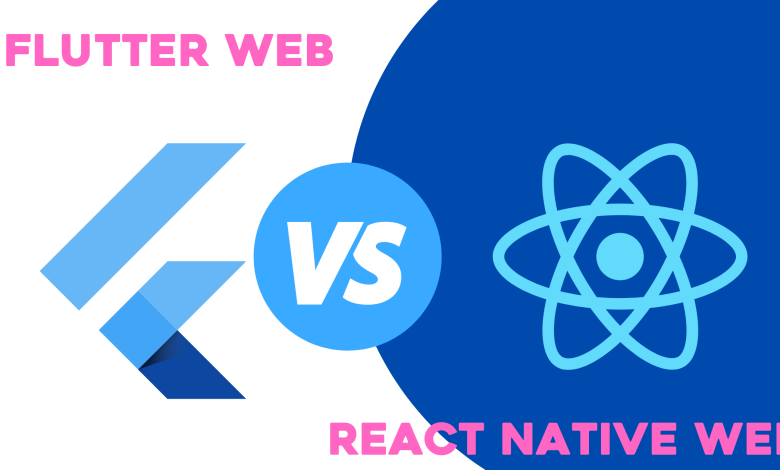Flutter Web VS React Native Web

Developers are always on the hunt for anything and everything that makes their development process faster and easier. With the increase in demand for applications, this requirement has only grown further. Fortunately, the introduction of React Native and Flutter has solved many of the problems faced by developers and has made their lives so much easier. As Flutter and React Native allow developers to build apps for both Android and iOS and desktop and web applications, they have helped them save a lot of time and effort. They are both extremely popular development frameworks and have made revolutionary changes in the app development industry. So how exactly are they different? This blog lets us compare frameworks and look closely into their web versions.
Comparing Flutter And React Native
Both Flutter and React Native app development frameworks are extremely popular and well-known. React Native is a product of Facebook, and Flutter is a product of Google, are both extremely powerful and high-performance app development tools. We have listed a few criteria below to put them face-to-face and compare their overall performance.
-
Beginner Friendliness
If we compare Flutter and React Native in terms of their ease of learning for new or beginner users, we could say that React Native is much simpler. This is because the setup process for React Native is much easier than Flutter.
-
Community
Community is another essential criterion to consider as it is the culmination of libraries and plugins, tutorials, forum/stack Overflow questions, and GitHub issues. Even though React Native is two years older than Flutter, it does not necessarily mean it is more popular. For example, Flutter has 125k stars on GitHub, while React Native only has 97k. On the other hand, they both have around 100k questions on Stack Overflow. In terms of usage, about 15% of all respondents are using React Native, while about 14% are using Flutter. However, React Native is more popular as it uses JavaScript when it comes to web app development.
-
Plugin Support
Flutter has a pretty decent plugin system that implements most of the commonly used functionalities in mobile apps. However, React Native exceeds Flutter, as it can use any npm module except for node modules with native dependencies.
-
App Performance
If your application does not require complex layouts, transitions, and passing of data to-fro the native side, either of the frameworks is good. On the other hand, if your app requires pure code performance, Flutter is the best choice as the code written is directly compiled into native code, while in React Native, the code must pass through the ‘Javascript bridge.’
-
Web Support
Web support for React Native is more mature than in Flutter. React Native web complies with actual HTML elements while Flutter uses the Canvas.
-
Testing And Deployment
React Native does not have testing and deployment tools and relies on community-built tools like React Native Testing Library, Jest, and Detox. On the other hand, Flutter has in-built testing support. You can use both of them with Fastlane, Bitrise, and many others for deployment.
Flutter Web – A Brief
Flutter web is the execution of Flutter that allows users to compile the Dart code used for building apps into HTML, CSS, and JavaScript code. They use web renderers and mainly use two kinds- HTML renderer and CanvasKit renderer. While the HTML renderer uses HTML, CSS, and Canvas API to produce pages, the CanvasKit renderer uses WebAssembly and WebGL.
The users of Flutter web have access to all the widgets available for mobile apps, and in the case of plugins, you cannot implement all of them on the web.
Advantages
- Stable and production-ready
- The complete and power-packed feature set
- Access to all the widgets available for Flutter mobile
- Complete access to all existing Dart libraries that run on the web
- Integration with IDEs and text editors
Disadvantages
- CanvasKit renderer requires a large download size
- Does not support all the JavaScript libraries
- Not SEO friendly
- More suitable for progressive web apps and games
React Native Web – A Brief
React Native web is an open-source project by Nicolas Gallagher, enabling developers to use React Native components and APIs. The most significant advantage of React Native is its ability to share code between platforms, meaning you only have to write a single code and can run it everywhere.
React Native web maps out web equivalents of components and APIs to make them available on the web. However, not all native components and APIs are available on the web, as most do not have an equivalent web API.
Advantages
- Includes tools that allow developers to build accessible apps
- Execution of web-specific code via platform detection
- Provides support for server-side rendering
- Expo web supports progressive web apps
Disadvantages
- React Native packages with native dependencies cannot be run on the web
- Those without native dependencies also may not work on the web
Final Thoughts
Both React Native web and Flutter web have their pros and cons and having to choose the one depends on the requirements and needs of your application. React Native for the web is production-ready and stays more true to the technologies that make the web work as it uses HTML, CSS, and JavaScript when it comes to web capabilities. Flutter for the web, on the other hand, is also production-ready but has issues with performance. Though most of the issue is solved by CanvasKit, developers have to wait longer to download the required scripts. Overall, both frameworks are significant initiatives, and we can boldly say that their future upgrades are highly anticipated.





